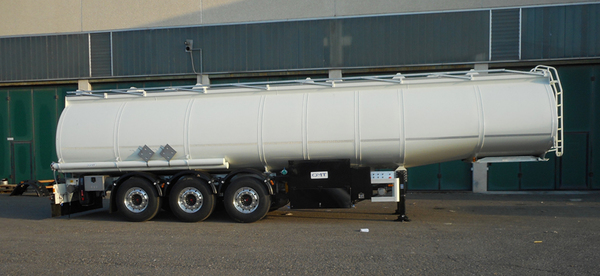The company OMT manufactures aluminium tanks for fuel transporters in its production halls. The special design of the containers consists of a series of "cups", which each consists of a base and a socket. This modular system was previously welded by a manual semi-automatic tacking operation with a mechanical carriage, which was mounted on the profile. A torch with a pre-set oscillating movement performed the welding uniformly along the circumference.
Due to higher demands in terms of work efficiency and precision, this system has been replaced by an igm robot system in order to stay at the top of the market in the future.
The robot cell consists of two separate and independent workstations so that the robot can work in one station, while the staff can unload and load the other one with the help of the hall- or service crane. This ensures an available weld time equal to the length of the shift without interruption to the part movement.
It goes without saying, that replacing the semi-automatic and mechanized welding process with igm robots, is a significant investment. This applies to economic aspects, infrastructure as well as staff training. However, even the data that emerged from the first tests have shown that it is a profitable decision:
- The cost of machine hours for a single seam has dropped by about 50%, reflecting on pure productivity as well as flexibility (potential production spikes are more easily absorbed without additional costs for overtime and difficult organization).
- The robot guarantees an almost constant quality, allows a statistically significant reduction of the defects and even corrects within certain tolerance limits the irregularities of the preparation.
- The robot ensures a constant and safe productivity, without fatigue, illnesses and breaks. It can even work the eight normal hours without supervision, which generates up to 10 hours of robot welding time, only by the use of the lunch break and a last cycle, which is started at the end of the shift.
- Another important aspect: the implementation of the robot cell has not led to a loss of jobs, but has significantly facilitated the work of the personnel involved, as physical work is now limited to assembling and moving parts.
- The uniformity (and inflexibility) of the times clocked by the robot also has a positive effect on the previous and subsequent operations, for which a kind of "domino effect" is expected in terms of efficiency and productivity also for the remainder of the welding work.
The statistics of the current phase of the acceptance test during which the service work (positioning and cleaning) was carried out at 50% of the possible speed, have already yielded very positive data. The cycle time of a production cycle (excluding manipulation times) has dropped from 101: 30min to 51: 35min, which corresponds to a reduction of around 51%! This would mean an amortization (ROI, return of investment) of the igm robot system within 4 years.









